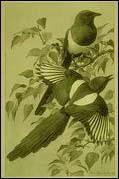|
Magpie: “one of those clever birds that has shamanic qualities” Minnehaha, the daughter of a Blackfoot tribe hunter, said to the buffalo herd, “Oh, if you would only come over the cliff, I would marry one of you.” She was surprised that they responded and tumbled over the cliff to provide food for her people. But she was carried away by the elder buffalo to be his bride. Her father searched for her and was stampeded to death. Minnehaha cried and asked the magpie to find a piece of her father's bones. The magpie found one, and Minnehaha chanted a song that brought her father to life. The buffalo chief said, if you teach that song of restoration to us, we'll sacrifice ourselves to feed your people. Then they taught her their sacred Buffalo Dance. — Joseph Campbell, The Power of Myth (1988), pp. 75-78
Magpie Symbolism
[PYC note: When I came across the good-evil dichotomy in east-west symbology for the magpie,
other examples came to mind. The
bat is a symbol of evil in the West associated with
vampires.
But in China it symbolizes good luck, because the
Chinese word "bat",
fu sounds like the word for "fortune".
Bats in Chinese Art.
In Europe,
Saint George
slays the evil dragon to rescue the
princess. However, the
Oriental dragon is a benevolent creature that brings forth the rain
and guards the sacred pearl of great price.]
Watchable Wildlife— Magpies
About Magpie, The Bird (Argonne National Laboratory)
Magpie-Larks are a small Australasian family composed of just two species in the genus Grallina:
the Magpie-lark and the Torrent-lark G. bruijni of New Guinea.
Fact Sheets: The Australian Magpie
Australian Magpie: Black Back, White Back, and Western
New Zealand Birds: Magpie
Formosan Blue Magpie Urocissa caerulea
The Magpie: From early ages, the magpie has been known as the lucky bird which delivers good news. The magpie inhabits Mountain Acha and Children's Grand Park but can be spotted anywhere. This intimate bird represents the bright future of Gwangjin-gu. (from Gwangjin-Gu district, Korea)
Magpie, a Symbol of Happiness Magpie: Pica Pica This black and white, black-billed, long-tailed Jay is the only member of its family to live in both hemispheres. It has long been known as a thief. Generally, this bird has bad thoughts attached to it and it was the symbol of garrulity. It was sacred to Bacchus, the God of wine, so it became associated with intoxication. (from Rutledge Books, Inc., subsidy publishing)
Louis Agassiz Fuertes: Magpie, Black-billed
The Lone Magpie Page
Raven's Aviary
* The Magpie and The Bell
* The Origins of the Buffalo Dance (similar to PBS story Joseph Campbell told to Bill Moyers)
* Magpie pays for bread it eats Claude Monet. The Magpie. c.1868-1869. Oil on canvas. Musée d'Orsay, Paris, France (Olga's Gallery) [PYC Note: I recall Charlie Rose asking Philippe de Montebello, Director of the Metropolitan Museum of Art, what is his favorite painting. Montebello walked Rose to Monet's Magpie and commented “It's a small painting (35" x 51"), but look at the snow, it's so perfect and peaceful.” Perhaps this Monet painting was on loan to the Met during their Impressionist Exhibit in 1994.] The Tame Magpie, circa 1707-08 (by Alessandro Magnasco, Italian, Genoese, 1677-1749): A man teaching a magpie to sing— an impossible task, Metropolitan Museum of Art
|
| Top of Page
| Magpies Notes
| Monet's Art
| A-Z Portals |
| References
| Enlightenment
| Romance
| Home |
![]()
| © Peter Y. Chou, WisdomPortal.com P.O. Box 390707, Mountain View, CA 94039 email: peter@wisdomportal.com (12-21-2001) |
 |


